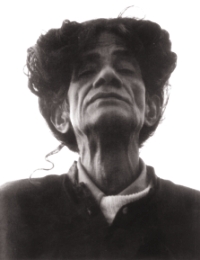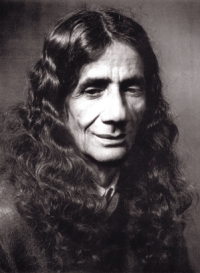|
Endeavour
Portrait of an Artist
A book titled 'Guru' celebrates the bohemian painter SM Sultan through Nasir Ali Mamun's chiaroscuro-laden photographs
Mustafa Zaman
 Nasir Ali Mamun's 'Guru', a huge photo album, is dedicated to the maverick painter SM Sultan. Mamun calls Sultan the "guru' and emphasises the fact that he had an unparalleled personality, of the kind which was unique among most other artists of the subcontinent. "He was a towering, lone figure at the beginning and he remained the same in his death. His lifestyle as well as his thoughts had set him far apart from his other contemporaries," points out Mamun who developed a passionate relationship with the artist. Nasir Ali Mamun's 'Guru', a huge photo album, is dedicated to the maverick painter SM Sultan. Mamun calls Sultan the "guru' and emphasises the fact that he had an unparalleled personality, of the kind which was unique among most other artists of the subcontinent. "He was a towering, lone figure at the beginning and he remained the same in his death. His lifestyle as well as his thoughts had set him far apart from his other contemporaries," points out Mamun who developed a passionate relationship with the artist.
"I would call it a sentimental attachment. As I had felt a deep affinity with the maestro in person, I was allowed to take photographs of him as he was going about his own
 |
Blissfully Aware, Sonargaon, 1978 |
daily drudgeries and artistic activities," says Mamun. He never asked the artist to pose for him, he just snapped when he felt the need to freeze a particular moment in the life of Sultan. Mamun met his famous model way back in 1977. And since that year he kept going back to Norail, where the maestro remained resident till he breathed his last in 1996, to take his photographs. He continued his effort for the next ten years. The result was more than six hundred photographs; most of which were in black and white.
In 1987 Mamun left the country and his documentation spree was broken. However, after coming back from abroad, he again went back to his subject in 1992. Although he did take some pictures in the nineties, none of them are included in the present show that
 |
Unfinished..., Dhaka, 1982 |
brings together 50 chosen photographs of Sultan. And the book too has been planned around the pictures taken in between 1977 and 1987. During that time only one colour reel was used. "A single colour slide was used either in the year 1978 or 1979," remembers Mamun. From that particular reel, nine of the colour photographs ended up on the walls of the Drik Gallery, where a five-day-long solo exhibition was launched on January 20. The launching of the 50 solo exhibition of Mamun titled "Guru" was also the occasion to launch the book of the same title. The exhibition as well as the book have been made possible only when architect Mubasshar Hussain, the executive director of Neer Limited an architecture firm, showed his personal interest in the Sultan photographs. "He came to know about the photographs of Sultan and immediately showed his interest in bringing out a book as well as putting up a show. He even paid for the framing of each photographs," Mamun discloses. Hussain's enthusiasm about anything that has to do with Sultan and the knowledge that a series of
 |
The kingdom of a Man, Masimdia, Narail, 1979 |
photographs taken by Mamun still lied with the photographer led to the meeting of the two. Their meetings of the minds have given birth to the beautifully planned exhibition and the book that would remain for posterity. While talking about the maestro Mamun still cannot hide his feeling of awe. The fact that he enamoured the late great artist Sultan through the lens still fuels his enthusiasm. Even in the small preface that he contributed to the book he expresses his veneration for Sultan and his out of the ordinary lifestyle. "Sultan doesn't belong to our time and his lifestyle is totally alien to us. In the village of Masimdia he used to live in a century-old dilapidated house with animals, birds, turtles and snakes," Mamun writes. His 50th exhibition showcases 50 pictures of Sultan. The book contains more then 60 pictures, all in black and white. This tome is the first of its kind. What it lacks is a text that would have corresponded to the photographs. Since the photographs look too aestheticised in expression, as the play of light and shade becomes the main muse of
 |
Playing Bamboo Flute, Chanchuri Purulia, 1980 |
Mamun, the need for an intimate running commentary on how, when and in what context the pictures were taken was an essential appendage that would have complimented the palettes. Mamun likes to refer to himself as a portraitist. The propensity for portraying illustrious personalities began in 1972. About his bias to capture noted personalities he has an offhand explanation; he contends that landscape and other subjects never inspired him much. "A landscape can always be photographed, but a man is only a passing visitor. I think man is more important than nature, in which he lives," he points out.
Since 1972 Mamun has amassed a collection of portraitures of many an illustrious personality of the country. Among which poet Jasimuddin's image has lately been celebrated in posters and in the literary supplement of the daily 'Prothom Alo'. Sultan's works has also been published in myriad of occasion in newspapers as well as periodicals. "The photograph that adorns the jacket of the book alone has been published more than twenty times," says Mamun. Though most of the images emerged in prints before, the book undoubtedly a treasure trove for the admirers of both Sultan and Mamun.
Copyright
(R) thedailystar.net 2006 |
